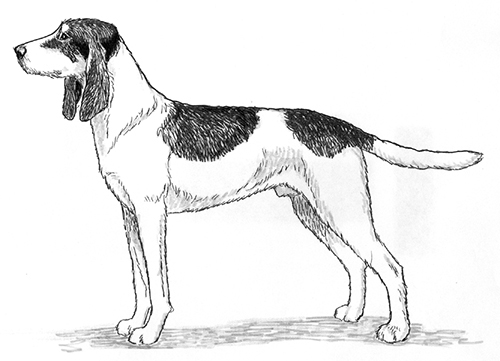Welsh Hound
Scenthound Group
The goals and purposes of this breed standard include: to furnish guidelines for breeders who wish to maintain the quality of their breed and to improve it; to advance this breed to a state of similarity throughout the world; and to act as a guide for judges.
Breeders and judges have the responsibility to avoid any conditions or exaggerations that are detrimental to the health, welfare, essence and soundness of this breed, and must take the responsibility to see that these are not perpetuated.
Any departure from the following should be considered a fault, and the seriousness with which the fault should be regarded should be in exact proportion to its degree and its effect upon the health and welfare of the dog and on the dog’s ability to perform its traditional work.
History
The Welsh Hound is also known as the Welsh Foxhound and Welsh Bytheuad. It is an ancient breed, thought to be descended from the extinct Celtic Hound and the old Staghound. Organized Hunts have kept well-known packs of pure Welsh Hounds for nearly 200 years.
The Welsh Hound was recognized by the United Kennel Club January 1, 2006.
General Appearance
The typical Welsh Hound is a low-scenting dog, with good shoulders, and a talkative, “loud†bark, being a prerequisite of hunting in the windy Welsh hillsides.
Characteristics
Sturdy, independent hunters, self-reliant in the rugged and rocky Welsh hills. Intelligent, loyal and happy.
Head
TEETH
The Welsh Hound has a complete set of evenly spaced, white teeth meeting in a scissors bite.
Disqualifications: Undershot bite. Overshot bite.
SKULL
The skull is slightly domed at the occiput. The cranium is broad and full. The stop is moderately defined.
MUZZLE
The straight, square cut muzzle is of fair length.
EARS
The long ears are set on moderately low, are almost absent of any erectile power, and set close to the head.
Neck
The neck is long, slightly arched and well developed without being coarse.
Forequarters
The long, well-sloped shoulders are well clothed with muscle, especially at the points, without being heavy.
FORELEGS
The forearm is long and muscular, but free from fat or lumber. The well-let-down elbows are set quite straight, and turn neither in nor out. The forelegs are long, straight and well boned down to the feet. The pasterns are strong.
Body
The chest is deep and the ribs are well sprung. The back is broad and level and there is a slight rise over the strong loin.
Hindquarters
The hindquarters are powerful and muscular.
HIND LEGS
The hind legs are well boned down to the feet. There is moderate turn of stifle. The hocks are well let down.
Feet
Round, tight, strong and well padded.
Tail
Well set on high, carried gaily but never curled over the back.
Coat
Rough and dense; of medium length. Occasionally smooth.
Color
Black, fawn, red, tan, white and mixed.
Height & Weight
Height: 24 inches.
Weight: 70 to 75 pounds
Gait
Free striding and tireless, with the ability to gallop. Strong drive from behind with no tendency to roll.
Disqualifications
(A dog with a Disqualification must not be considered for placement in a conformation event, and must be reported to UKC.)
Unilateral or bilateral cryptorchid.
Viciousness or extreme shyness.
Albinism.
Undershot bite.
Overshot bite.

Looking for a Dog?
Find a dog that will fit your family.
Note: The breeders on this list are not endorsed by UKC.
©Copyright 2006, United Kennel Club
